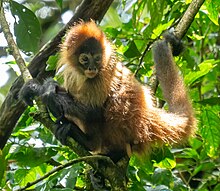The ornate spider monkey (Ateles geoffroyi ornatus) is a subspecies of Geoffroy's spider monkey, a type of New World monkey,[1] from Central America, native to Costa Rica and Panama.[2][4][5] Other common names for this subspecies include the brilliant spider monkey, the common spider monkey, the red spider monkey, the Panama spider ape, and the Azuero spider monkey; the latter two of which were previously thought to be distinct subspecies, panamensis and azuerensis, respectively.[1]
| Ornate spider monkey[1] | |
|---|---|

| |
| Scientific classification | |
| Domain: | Eukaryota |
| Kingdom: | Animalia |
| Phylum: | Chordata |
| Class: | Mammalia |
| Order: | Primates |
| Suborder: | Haplorhini |
| Infraorder: | Simiiformes |
| Family: | Atelidae |
| Genus: | Ateles |
| Species: | |
| Subspecies: | A. g. ornatus
|
| Trinomial name | |
| Ateles geoffroyi ornatus (Gray, 1870)
| |
| Synonyms | |
| |

References
edit- ^ a b c Groves, C. P. (2005). Wilson, D. E.; Reeder, D. M. (eds.). Mammal Species of the World: A Taxonomic and Geographic Reference (3rd ed.). Baltimore: Johns Hopkins University Press. ISBN 0-801-88221-4. OCLC 62265494.
- ^ a b Solano-Rojas, D.; Cortes-Ortíz, L.; Méndez-Carvajal, P.G. (2020). "Ateles geoffroyi ssp. ornatus". IUCN Red List of Threatened Species. 2020: e.T2289A17979560. doi:10.2305/IUCN.UK.2020-2.RLTS.T2289A17979560.en. Retrieved 11 November 2021.
- ^ "Appendices | CITES". cites.org. Retrieved 2022-01-14.
- ^ Rylands, A. & Members of the Primate Specialist Group (2003). "Ateles geoffroyi ssp. panamensis". IUCN Red List of Threatened Species. 2003. Retrieved 2008-07-26.
- ^ Méndez-Carvajal, P.G.; Cortes-Ortíz, L. (2020). "Ateles geoffroyi ssp. azuerensis". IUCN Red List of Threatened Species. 2020: e.T2286A195990183. doi:10.2305/IUCN.UK.2020-2.RLTS.T2286A195990183.en. Retrieved 11 November 2021.
External links
edit- http://www.azueroearthproject.org
- http://www.speciesconservation.org/projects/Azuero-Spider-Monkey/586
- http://environment.yale.edu/elti/
- [1]
